View in other NatureServe Network Field Guides
NatureServe
Montana
Utah
Wyoming
Idaho
Wisconsin
British Columbia
South Carolina
Yukon
California
New York
Slender Grouse Locust - Tetrix subulata
Other Names:
Awl-shaped Pygmy Grasshopper
General Description
The following comes from Brooks (1958), Helfer (1971), Vickery and Kevan (1985), Bland (2003), and Scott (2010). An exceedingly small grasshopper with a long, pointed roof-like pronotum extending posteriorly beyond the abdominal tip. Body color is variable grayish to reddish brown, sometimes darker and often with a dorsal median longitudinal whitish stripe. This species is more frequently attracted to lights at night than other species of Tetrix.
Phenology
The following is taken from Brooks (1958), Helfer (1971), Bland (2003), Scott (2010), and Vickery and Kevan (1985). Usually overwinters in the adult stage or as a late-stage nymph. Eggs are laid in May to June, the nymphs reaching the adult stage in fall. Adult populations decline in late August and September as these overwintered survivors die, and peak again in August and September as the new generation of nymphs mature. In some areas, this species is sometimes collected throughout the year, but generally found from mid-March to mid-September.
Diagnostic Characteristics
The following comes from Brooks (1958), Helfer (1971), Vickery and Kevan (1985), Bland (2003), and Scott (2010). The body length to end of forewings ranges from 7 to 12 mm for both males and females. However, females tend to be larger than males as measured by the length of the pronotum, which for males is 10 mm to 10.5 mm and females 11.9 to 12.5 mm. The middle leg femur is slender, measuring 3.8 to 1.7 times as long as broad. This species, as well as other
Tetrix species are quite variable in color patterns due to polymorphism, the occurrence of genetically different forms of individuals within the same species or interbreeding population.
Could be confused with the
Striped Ground Cricket (
Allonemobius fasciatus), which possess an extended wing “look-a-like” to
T. subulata’s pronotum. Compare with the other two pygmy grasshoppers occurring in Montana. Refer to
Ornate Pygmy Grasshopper (
Tetrix ornata) and
Brunner's Grouse Locust (
Tetrix brunnerii) for diagnostic characteristics for positive identification.
Species Range
Montana Range
Range Descriptions
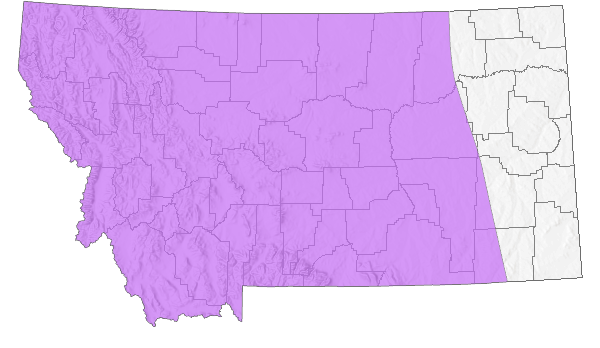
 Native
Native
Range Comments
This species has an around-the-world distribution occurring in the boreal regions of Europe and Asia. In North America, it occurs from Alaska, across all the Canadian Provinces, and southward into New Mexico and Arizona to North Carolina. In Montana, it has been reported for 10 counties (Bland 2003, Brooks 1958, Hebard 1928, Helfer 1971, Scott 2010, and Vickery and Kevan 1985).
Observations in Montana Natural Heritage Program Database
Number of Observations: 15
(Click on the following maps and charts to see full sized version)
Map Help and Descriptions
Relative Density
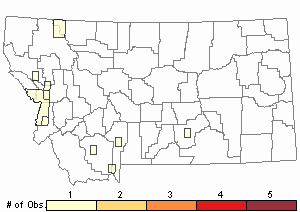
Recency
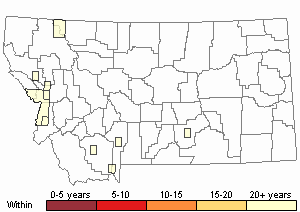

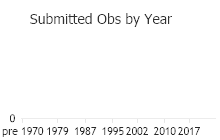
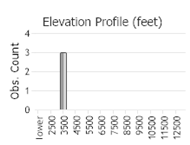 (Observations spanning multiple months or years are excluded from time charts)
(Observations spanning multiple months or years are excluded from time charts)
Habitat
The Slender Grouse Locust frequents moist sandy habitats along streams, pond and lake margins, marshes, and bogs. It is occasionally found in drier cultivated areas and forests (Bland 2003, Brooks 1958, Brust et al. 2008, Hebard 1928, Helfer 1971, Hochkirch et al. 2000, and Vickery and Kevan 1985).
Food Habits
The Pygmy Grasshoppers specialize in feeding on the lower plants such as algae, mosses, fungi and lichens, but also, humus and detritus. Grasses and forbs are only consumed at the sprouting state when the leaves are small and tender (Hochkirch et al. 2000).
Reproductive Characteristics
The following comes from Forsman (2018), Hochkirch et al. (2000), and Vickery and Kevan (1985). The mating strategy of the Slender Grouse Locust is polyandrous, in which the female mates with more than one male during the breeding season. In one study, 60 females were presented with 4 different males. No female mated only with just one male, whereas 8 females mated with 2 different males, 27 females mated with 3 different males, and 25 females mated with all 4 males. This strategy appears to be the sexual modii operandi of many, if not all, Tetrix species. Females survive one reproductive season and produce multiple pods of eggs consisting of up to 35 eggs per pod. Male nymphs pass through 5 instars and female nymphs pass through 6 instar stages before reaching the adult stage. Intraspecific variability is huge within Tetrix species in their morphology, color and pattern, physiology, behavior and life-history, even within individuals in a population.
Stewardship Responsibility
References
- Literature Cited AboveLegend:
 View Online Publication
View Online Publication Bland, R.G. 2003. The Orthoptera of Michigan—Biology, Keys, and Descriptions of Grasshoppers, Katydids, and Crickets. East Lansing, MI: Michigan State University Extension, Bulletin E-2815. 221 p.
Bland, R.G. 2003. The Orthoptera of Michigan—Biology, Keys, and Descriptions of Grasshoppers, Katydids, and Crickets. East Lansing, MI: Michigan State University Extension, Bulletin E-2815. 221 p. Brooks, A.R. 1958. Acridoidea of Southern Alberta, Saskatchewan, and Manitoba (Orthoptera). The Canadian Entomologist (Supplement 9) 90:5-92.
Brooks, A.R. 1958. Acridoidea of Southern Alberta, Saskatchewan, and Manitoba (Orthoptera). The Canadian Entomologist (Supplement 9) 90:5-92. Brust, M.L, W.W. Hoback, and R.J. Wright. 2008. The Grasshoppers of Nebraska. Lincoln, NB: University of Nebraska Extension Service, APHIS.
Brust, M.L, W.W. Hoback, and R.J. Wright. 2008. The Grasshoppers of Nebraska. Lincoln, NB: University of Nebraska Extension Service, APHIS. Forsman, A. 2018. On the role of sex differences for evolution in heterogeneous and changing fitness landscapes: insights from pygmy grasshoppers. Philosophical Transactions of the Royal Society B 373(1757):1-10. http://doi.org/10.1098/rstb.2017.0429
Forsman, A. 2018. On the role of sex differences for evolution in heterogeneous and changing fitness landscapes: insights from pygmy grasshoppers. Philosophical Transactions of the Royal Society B 373(1757):1-10. http://doi.org/10.1098/rstb.2017.0429 Hebard, M. 1928. The Orthoptera of Montana. Proceedings of the Academy of Natural Sciences of Philadelphia, Vol. 80:211-306.
Hebard, M. 1928. The Orthoptera of Montana. Proceedings of the Academy of Natural Sciences of Philadelphia, Vol. 80:211-306. Helfer, J.R. 1971. How to Know the Grasshoppers, Crickets, Cockroaches, and Their Allies. Revised edition (out of print), Mineola, NY: Dover Publications.
Helfer, J.R. 1971. How to Know the Grasshoppers, Crickets, Cockroaches, and Their Allies. Revised edition (out of print), Mineola, NY: Dover Publications. Hochkirch, A., J. Groning, T. Loos, C. Metzing, and M. Reichelt. 2000. Specialized diet and feeding habits as key factors for the habitat requirements of the grasshopper species Tetrix subulata (Orthoptera: Tetrigidae). Entomol Gener 25(1):039-051.
Hochkirch, A., J. Groning, T. Loos, C. Metzing, and M. Reichelt. 2000. Specialized diet and feeding habits as key factors for the habitat requirements of the grasshopper species Tetrix subulata (Orthoptera: Tetrigidae). Entomol Gener 25(1):039-051. Scott, R.D. 2010. Montana Grasshoppers, Katydids, and Crickets A Pictorial Field Guide to the Orthoptera. MagpieMTGraphics, Billings, MT.
Scott, R.D. 2010. Montana Grasshoppers, Katydids, and Crickets A Pictorial Field Guide to the Orthoptera. MagpieMTGraphics, Billings, MT. Vickery, V. R. and D. K. M. Kevan. 1985. The grasshopper, crickets, and related insects of Canada and adjacent regions. Biosystematics Research Institute, Ottawa, Ontario. Publication Number 1777. 918 pp.
Vickery, V. R. and D. K. M. Kevan. 1985. The grasshopper, crickets, and related insects of Canada and adjacent regions. Biosystematics Research Institute, Ottawa, Ontario. Publication Number 1777. 918 pp.
- Additional ReferencesLegend:
 View Online Publication
View Online Publication
Do you know of a citation we're missing? Capinera, J.L., R.D. Scott, and T.J. Walker. 2004. Field Guide to Grasshoppers, Katydids, and Crickets of the United States. Ithaca, NY. Cornell University Press.
Capinera, J.L., R.D. Scott, and T.J. Walker. 2004. Field Guide to Grasshoppers, Katydids, and Crickets of the United States. Ithaca, NY. Cornell University Press. Sater, S. 2022. The insects of Sevenmile Creek, a pictorial guide to their diversity and ecology. Undergraduate Thesis. Helena, MT: Carroll College. 242 p.
Sater, S. 2022. The insects of Sevenmile Creek, a pictorial guide to their diversity and ecology. Undergraduate Thesis. Helena, MT: Carroll College. 242 p.
- Web Search Engines for Articles on "Slender Grouse Locust"
- Additional Sources of Information Related to "Insects"





